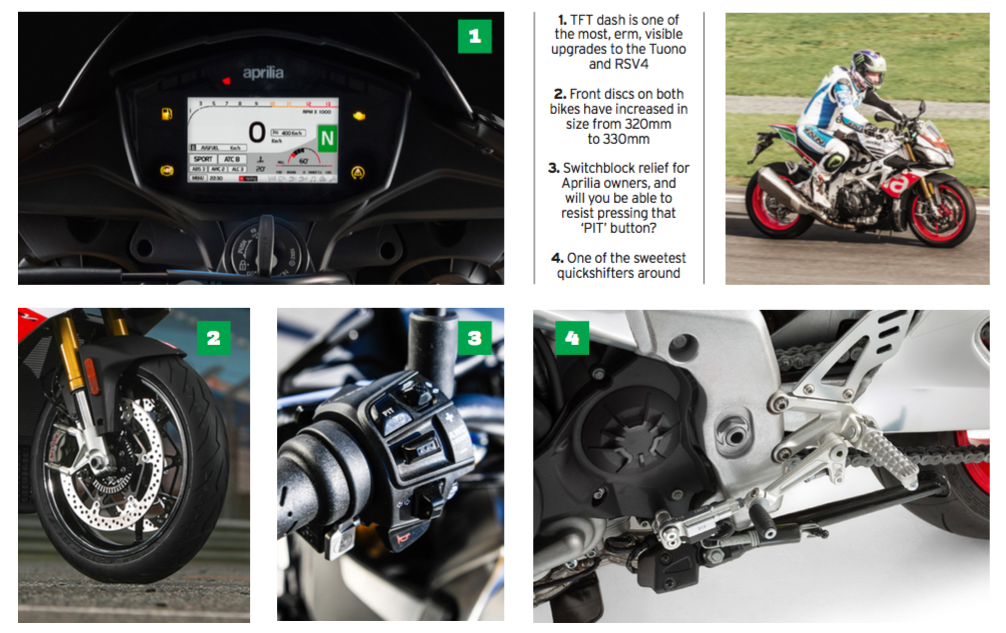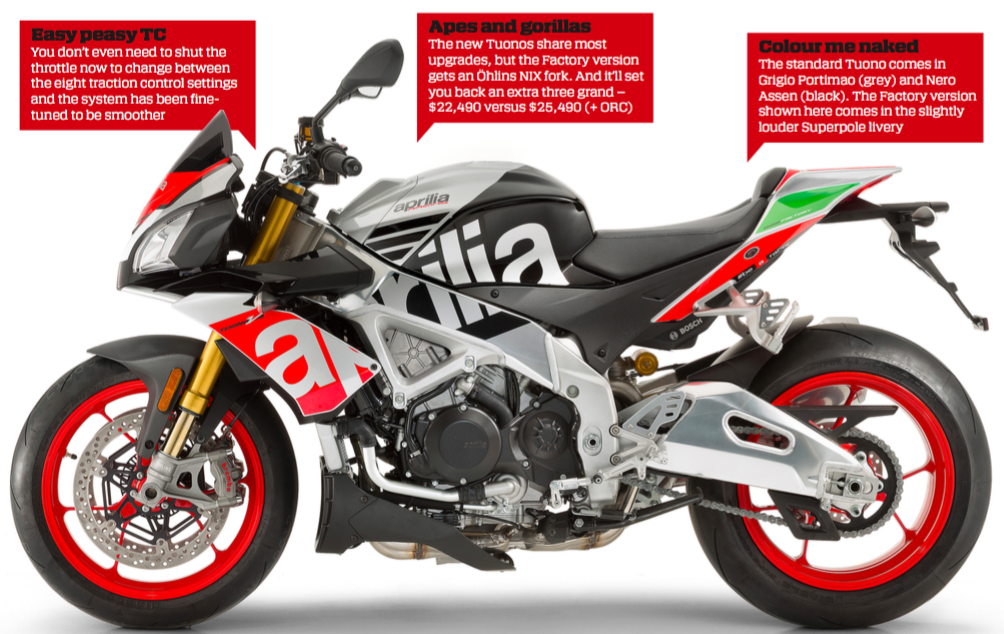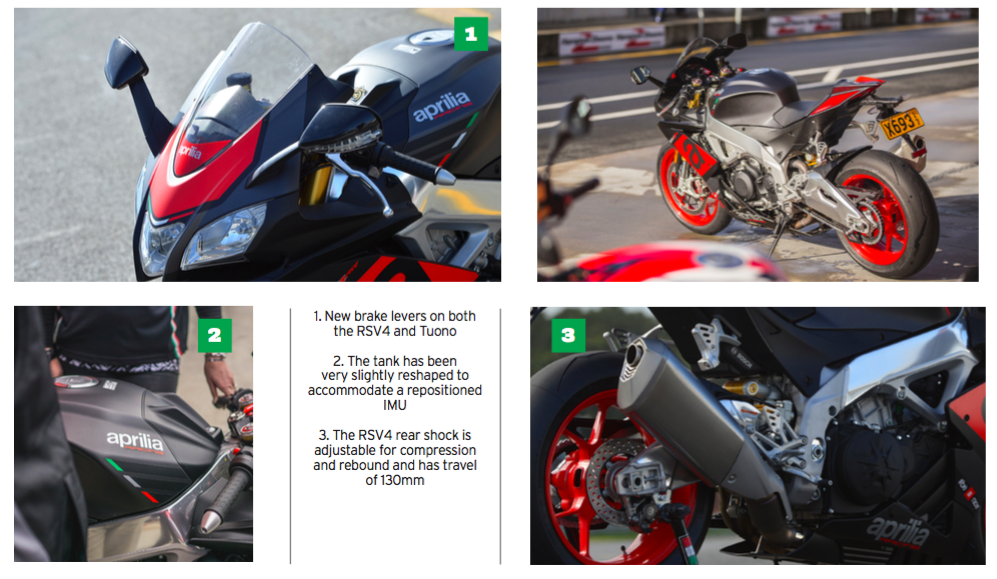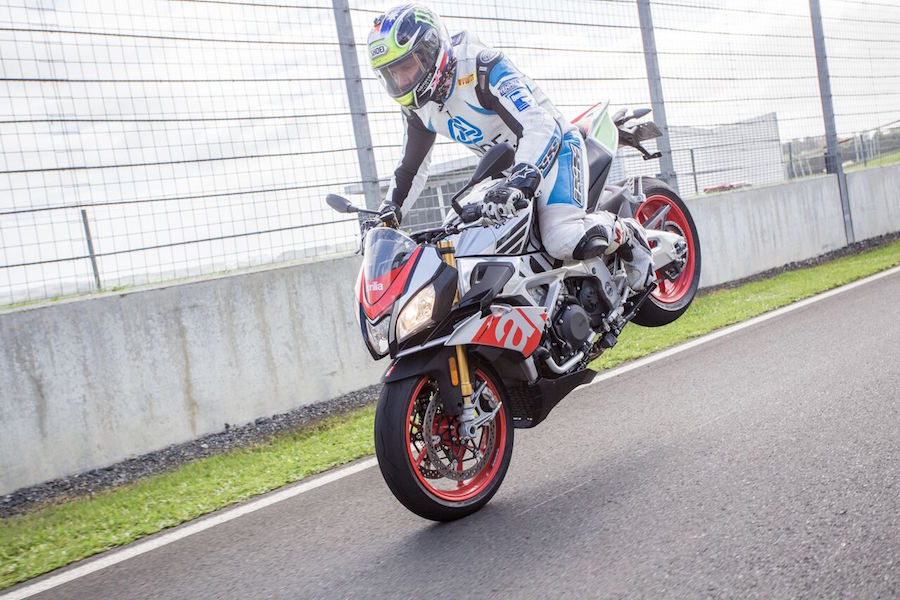Aprilia has unleashed updated versions of its two greatest weapons, but will it make a difference in the ongoing quest for motorcycle domination? Steve Martin hits the track to find out...
2017 APRILIA RSV4 RR & TUONO V4 1100: With 54 world titles and more than 300 race wins, Aprilia is a manufacturer whose competitive pedigree cannot be disputed. And since the inception of its 65º V4 alloy-framed RSV back in 2009, things have been pretty rosy. Seven WSBK titles (rider and manufacturer included) are testament to its ability on the track, and as a roadbike it has been improving year after year like a good red wine.
In 2011, the RSV4 gained a sister when the Tuono 1000 was redesigned around the V4 engine, but at that early stage of development it was simply a stripped-down racebike. It wasn’t until 2015 that Aprilia got serious with the Tuono, giving it a capacity boost from 998.9cc up to 1077cc and taking the hard edge off the racer to make it the most comfortable grunt monster money could buy.
Both bikes have been around for a while now and have been very successful in their own fields. Last year’s models were excellent and won many accolades – including, in the case of the Tuono Factory, AMCN’s coveted Motorcycle of The Year gong. But in some areas they perhaps still fell a little short of the competition.
With the 2017 bikes appearing on showroom floors, has Aprilia been able to push its exotic animals ahead of the pack? We flew across to New Zealand, and rode copious amounts of laps of the beautiful Hampton Downs race circuit just south
of Auckland to find out.

Rain, rain go away
It’s never good waking up to the sound of rain when you’ve travelled to another country to test a bike, and it was still wet when we arrived at the circuit at 7am. But the morning got a bit brighter when I stepped into pitlane and saw the beautiful RSV4 RR and next to it a stunning Tuono V4 1100 Factory, kindly supplied by the NZ importer.
As we waited for the track to dry, the forced downtime gave me an opportunity to peruse the changes on the 2017 machines. There’s quite a lot that’s new when you get into it, probably the first big tick is that both bikes are now Euro 4 compliant. It’s not just a matter of putting in some restrictors to meet the tough regulations, either – these machines have had modifications to reduce emissions and yet retain performance. Internally the new Euro 4 bits do a good job by not softening that throaty growl that makes you want to start these bikes up in the garage every night, even without going for a spin.
The Tuono has had a new 64MHz ECU fitted with different software to manage an engine that revs 500rpm higher than last year. The wrist pins have been coated and the rod end eyes honed to improve the durability too. On a bike that already boasts the most power in its class, the only other thing needed was a newly designed pipe to make the package come together. The Tuono now produces 129kW and 121Nm, so there’s a lot of fun waiting to be had.

The RSV4, on the other hand, has a very serious job to do: win races. As a result, it’s had more modifications than its naked sister to keep it near the top of the heap in the superbike class. As well as weight-saving engine internals (see left), it gets the same new ECU as the Tuono and an extra 300rpm added to last year’s redline. There’s also different valve timing for better reliability and the same honing of the rods that the Tuono received, all in the name of making a better track/racebike.
Chassis-wise both bikes retain the fully adjustable alloy spar frame they’ve always had. Both also allow the owner to reposition the engine in the frame GP-style (if you want to cut a couple seconds off your PB time to the café), and the link ratio and swingarm remain unchanged on the Tuono. The up-spec RSV4 RF has a progressive link, but there wasn’t one on hand to try. Hopefully we’ll get an example for AUSTest 2017 – stay tuned.

It’s the ergonomics of both bikes that have changed the most, specifically around the dash and hand control area. The left switchblock now has a toggle button that allows the rider to scroll through the menu on the new Thin Film Technology (TFT) dash much more easily than on last year’s machines. It’s now self-explanatory rather than a guessing game to change the functions, and that is a big plus as adjusting the electronics is such a big part of riding these days.
The bikes still have the cool plus and minus buttons for traction control, which can be adjusted on the move. And then there’s the other cool switch, added for the first time: cruise control. With these bikes having so much grunt, cruise control is a major asset on the freeway for keeping you in check – and your licence intact.
There’s also an infotainment system available as an option for the standard models and pre-mounted on the higher-spec RF /Factory bikes. With this system, you can now connect your phone through the dash and receive calls using the new switchblock. The caller name or number comes up on the TFT dash, giving you the option to answer or not. Chris Dobie calling? Sorry, busy!

There has also been a raft of improvements to the riding aids with everything getting smoother and more efficient. The Inertial Measurement Unit (IMU) has been fitted in a better place to more accurately determine the plane of the bike and feed into all the background systems that keep you safe.
The biggest buzz item though is the bidirectional quickshifter, which allows clutchless changes up and down the box at any throttle setting. The shifter is the best available on the market that I’ve tested, and brings racetrack superbike technology to the road. The advantage that the Aprilia system boasts is its ability to match revs to rpm and road speed up and down the box at any throttle position, whereas some of the other manufacturers need a closed throttle on the down change.

The ride
Although the RSV4 RR is the base superbike model of the two available, it’s still an incredibly exciting machine. From the moment you hit the starter button it gives you a business-like growl that somehow is dangerous and docile at the same time.
But it’s on the track where you really start to get an understanding of how tractable the powerplant can be, especially in damp conditions like those I faced at Hampton Downs. The V4 lets you feel the grip and it almost seems like the tyre is connected to the throttle grip. As I twisted on the gas, every pulse could be felt and tracked through to the wheel; it never feels like it’s going to spin up and get away from you, or spit you off.
That tame nature ends, however, when you get onto a straight section and give it the berries. The bike shoots forward rapidly and the front wheel lofts skywards, though wheelie control keeps things in check, making sure there is always contact with the ground. Unless, of course, you turn it off. That’s when the real fun starts.
Banging through the gearbox on the upshift full throttle with the wheelie control off is a hoot, and to be honest it’s faster than with the system turned on. The system has improved significantly from last year, but like all manufacturers’ modern systems it’s track ready, not race ready.
That gearshift program, on the other hand, could be put straight on a racebike as it’s perfect. You don’t need to think, just change gear at any rev, at any throttle position, and it copes with the rest.
I played a lot with the traction settings and was very impressed with its ability to feel the grip level available on the circuit, which was quite varied due to the morning rain. The reaction was instantaneous, giving me confidence that the bike was going to do what I told it and stay online, rather than spin up and give me a moment.

As the track dried though and I started having a real dip, I needed to back the traction settings to low. In the system’s defence, I had the rear spinning a lot on the standard tyres and with some stickier ones fitted it would be less of an issue. It’s also like all the modern sportsbikes in this aspect – it’s set up on the verge of safety rather than outright performance, which makes it better for 99 per cent of the population.
Three different ABS settings are available: Track, Sport and Rain. There is also a Rear Wheel Lift Mitigation system that monitors front/rear wheel speed and alters brake pressure automatically to keep the rear on the ground.
For me the RSV4 brakes gave excellent feel at high speeds. They are nowhere near as sensitive as the Tuono, making it easier to grab a handful on the limit without making a mistake, and the lean-angle-activated ABS worked well, not once letting me know it was on – provided I had the correct setting.
Importantly I could tuck in quite easily under the fairing, and as far as sportsbikes go, I felt very comfortable. It’s an aspect I’ve always enjoyed when riding the RSV4 range. Perhaps it’s just me but it fits my 173cm frame like a glove.
Handling is another highlight with the RSV range. I didn’t have to adapt to these bikes – they’re very neutral and steer exactly where you point them. The fully adjustable Sachs suspension on the standard bike didn’t need tweaking and felt just right. It’s supposedly lower quality compared to the Öhlins unit on the RF model, but it’s still very damn good. Then, after about 20 laps, it was time to come in and take the Tuono out for a mellow spin.

Tuono and lightning
Who am I kidding – the Tuono is anything but mellow. This was the first time I’d ridden the Factory version on track, and compared to the 2015 model RR I rode around Sydney Motorsport Park a couple of years ago it is magnificent.
After the track-oriented RSV4, I was expecting a saggy ride, but Öhlins has worked wonders, making this bike handle like a superbike while keeping it super plush and comfortable. I thought the RSV4 was good at bump absorption, but it’s uncanny how the Tuono smooths out the road, or in my case the track, and yet it still holds its line nearly everywhere.
The back felt slightly soft coming flat out through the last long sweeper at Hampton Downs but unless you plan on riding your Tuono in the IOM TT you will be fine. There’s also the option to tighten up the fully adjustable TTX rear shock.
The 1100cc engine in the Tuono has more torque than the 1000 and you can feel it on track. It’s hard not to be silly really – with the copious amounts of power at hand and that upright seating position, showing off has never been easier. The way the power is delivered is what really gets your attention though. It’s so smooth with no jerkiness and a very linear build of power.
The ergonomics of the seat, ’pegs and ’bar is well thought out and a lot more comfortable than the crouched styling of the superbike, something that’s sure to appeal to real world riders. The dash is easy to read and displays plenty of data with a digital speedo most prominent. There are also trip meters, fuel consumption, engine maps, time, rpm, aPRC (aprilia Performance Ride Control) settings, connectivity settings and a lot more. The dash background even automatically changes from white to black at night for less glare.

The handling of the Tuono has never been in doubt, and having extensively ridden one on road last year and now on the track this year I can confirm that the magic sense of confidence is still there. The RSV has always been good, and the Tuono is getting better and closer to its sister bike’s racing character with every new model.
I have to admit I’ve always been a big fan of any V4 motor. They really do give a different feel to the others and it’s a feel that I like. Both the RSV and Tuono were a pleasure to ride at Hampton Downs and when the conditions were tricky I could almost hear each bike telling me that they had my back.
As the dust settled – or in the case of Hampton Downs, the track dried – I had a quiet moment of reflection. Have these two models done enough to keep them in the hunt for superbike supremacy? The TFT dash alone on the Factory Tuono lifts what was already a very classy motorcycle, and the fact that it’s the current AMCN MoTY speaks volumes about our faith in this bike. It’s still the king for now, but it will need all its upgrades to stave off the ever-improving competition.
The RSV, meanwhile, will be judged by its racetrack performances around the world – as all sportsbikes are. It’s a big step forward, especially in the area of user friendliness and refinement, but is it the fastest? On its day and the right track, with the right rider … I know, I know, that’s a cop-out. Let’s just say it’s already shaping up as a dark horse for our AUSTest 2017 – bring on September!

By STEVE MARTIN
Photography JASON HASELDEN